HYUNDAI ACCENT 2022 Owners Manual
Manufacturer: HYUNDAI, Model Year: 2022, Model line: ACCENT, Model: HYUNDAI ACCENT 2022Pages: 443, PDF Size: 42.78 MB
Page 291 of 443
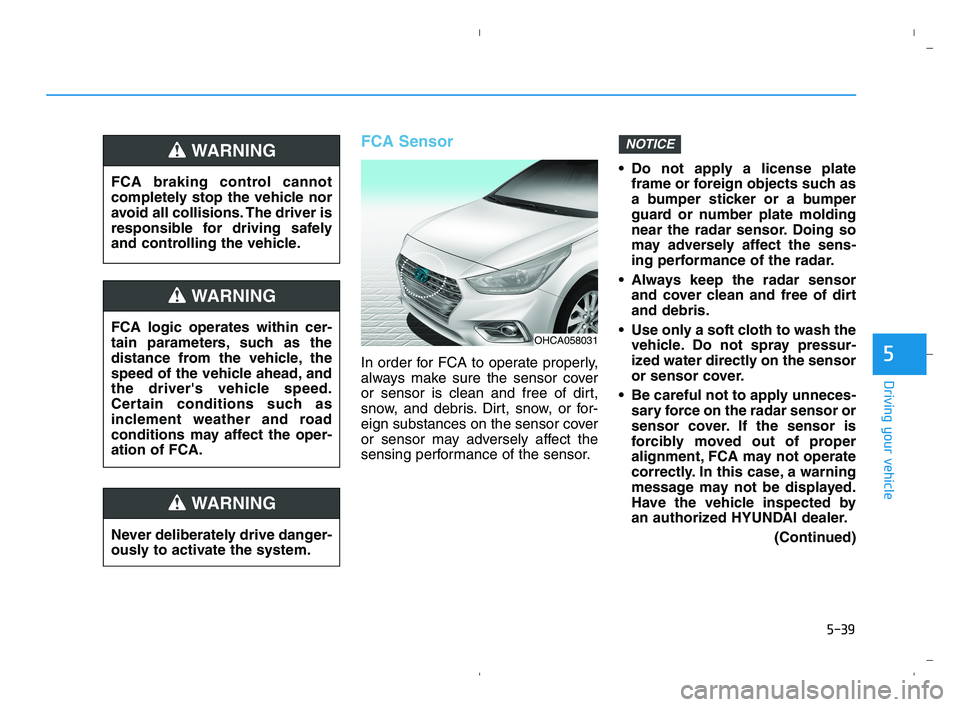
5-39
Driving your vehicle
5
FCA Sensor
In order for FCA to operate properly,
always make sure the sensor cover
or sensor is clean and free of dirt,
snow, and debris. Dirt, snow, or for-
eign substances on the sensor cover
or sensor may adversely affect the
sensing performance of the sensor. Do not apply a license plate
frame or foreign objects such as
a bumper sticker or a bumper
guard or number plate molding
near the radar sensor. Doing so
may adversely affect the sens-
ing performance of the radar.
Always keep the radar sensor
and cover clean and free of dirt
and debris.
Use only a soft cloth to wash the
vehicle. Do not spray pressur-
ized water directly on the sensor
or sensor cover.
Be careful not to apply unneces-
sary force on the radar sensor or
sensor cover. If the sensor is
forcibly moved out of proper
alignment, FCA may not operate
correctly. In this case, a warning
message may not be displayed.
Have the vehicle inspected by
an authorized HYUNDAI dealer.
(Continued)
NOTICE
FCA logic operates within cer-
tain parameters, such as the
distance from the vehicle, the
speed of the vehicle ahead, and
the driver's vehicle speed.
Certain conditions such as
inclement weather and road
conditions may affect the oper-
ation of FCA.
WARNING
FCA braking control cannot
completely stop the vehicle nor
avoid all collisions. The driver is
responsible for driving safely
and controlling the vehicle.
WARNING
Never deliberately drive danger-
ously to activate the system.
WARNING
OHCA058031
HCa HMA 5.QXP 5/25/2020 10:21 AM Page 39
Page 292 of 443
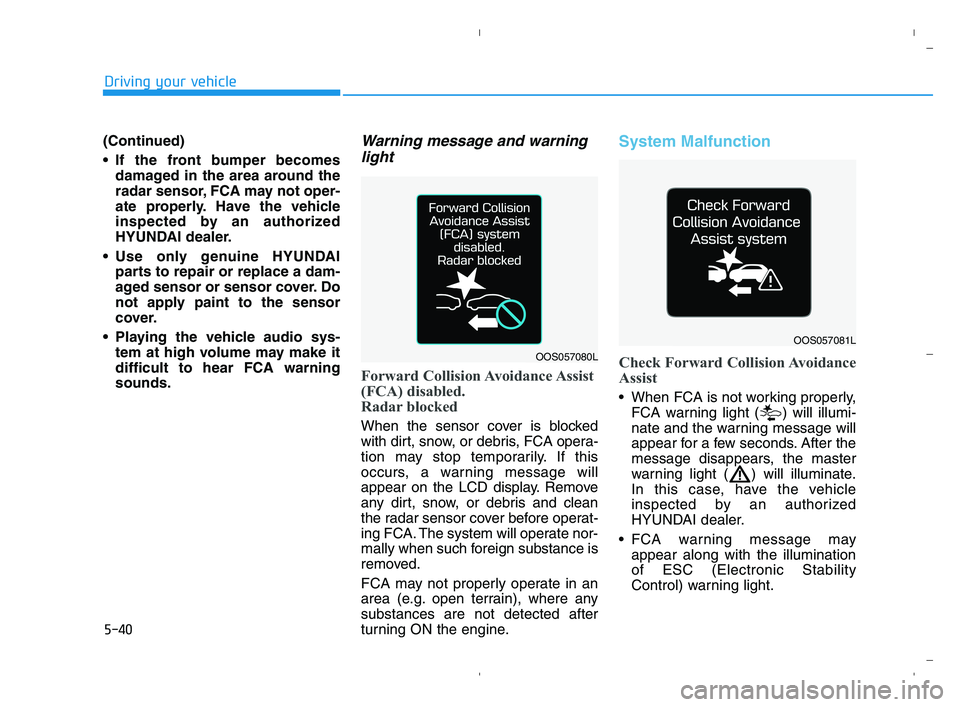
5-40
Driving your vehicle
(Continued)
If the front bumper becomes
damaged in the area around the
radar sensor, FCA may not oper-
ate properly. Have the vehicle
inspected by an authorized
HYUNDAI dealer.
Use only genuine HYUNDAI
parts to repair or replace a dam-
aged sensor or sensor cover. Do
not apply paint to the sensor
cover.
Playing the vehicle audio sys-
tem at high volume may make it
difficult to hear FCA warning
sounds.
Warning message and warning
light
Forward Collision Avoidance Assist
(FCA) disabled.
Radar blocked
When the sensor cover is blocked
with dirt, snow, or debris, FCA opera-
tion may stop temporarily. If this
occurs, a warning message will
appear on the LCD display. Remove
any dirt, snow, or debris and clean
the radar sensor cover before operat-
ing FCA. The system will operate nor-
mally when such foreign substance is
removed.
FCA may not properly operate in an
area (e.g. open terrain), where any
substances are not detected after
turning ON the engine.
System Malfunction
Check Forward Collision Avoidance
Assist
When FCA is not working properly,
FCA warning light ( ) will illumi-
nate and the warning message will
appear for a few seconds. After the
message disappears, the master
warning light ( ) will illuminate.
In this case, have the vehicle
inspected by an authorized
HYUNDAI dealer.
FCA warning message may
appear along with the illumination
of ESC (Electronic Stability
Control) warning light.
OOS057080L
OOS057081L
HCa HMA 5.QXP 5/25/2020 10:21 AM Page 40
Page 293 of 443
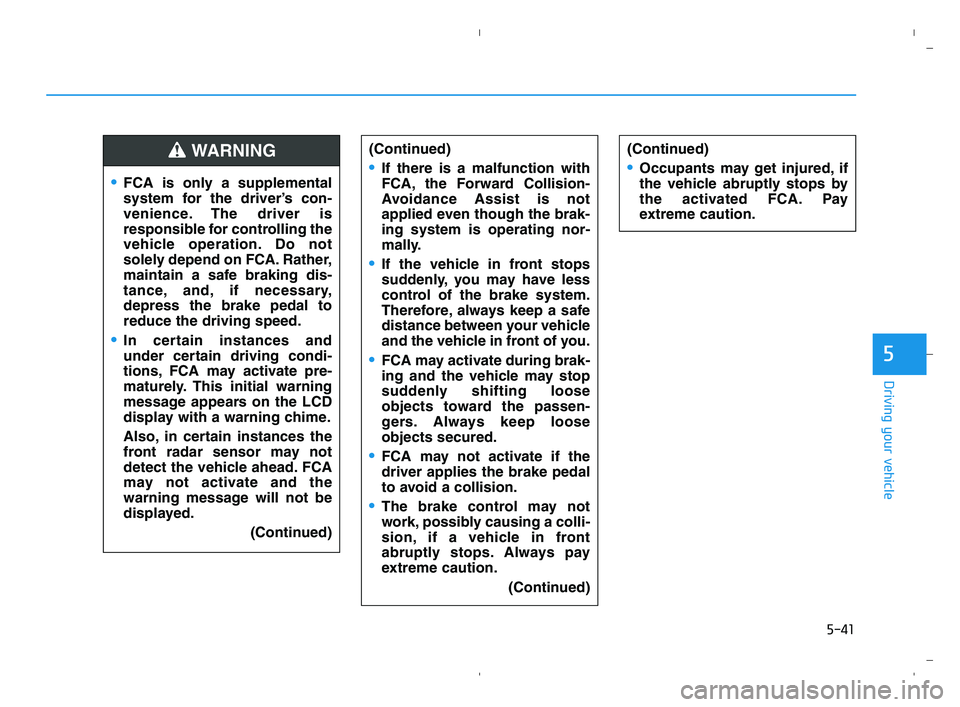
5-41
Driving your vehicle
5
FCA is only a supplemental
system for the driver’s con-
venience. The driver is
responsible for controlling the
vehicle operation. Do not
solely depend on FCA. Rather,
maintain a safe braking dis-
tance, and, if necessary,
depress the brake pedal to
reduce the driving speed.
In certain instances and
under certain driving condi-
tions, FCA may activate pre-
maturely. This initial warning
message appears on the LCD
display with a warning chime.
Also, in certain instances the
front radar sensor may not
detect the vehicle ahead. FCA
may not activate and the
warning message will not be
displayed.
(Continued)
WARNING (Continued)
If there is a malfunction with
FCA, the Forward Collision-
Avoidance Assist is not
applied even though the brak-
ing system is operating nor-
mally.
If the vehicle in front stops
suddenly, you may have less
control of the brake system.
Therefore, always keep a safe
distance between your vehicle
and the vehicle in front of you.
FCA may activate during brak-
ing and the vehicle may stop
suddenly shifting loose
objects toward the passen-
gers. Always keep loose
objects secured.
FCA may not activate if the
driver applies the brake pedal
to avoid a collision.
The brake control may not
work, possibly causing a colli-
sion, if a vehicle in front
abruptly stops. Always pay
extreme caution.
(Continued)
(Continued)
Occupants may get injured, if
the vehicle abruptly stops by
the activated FCA. Pay
extreme caution.
HCa HMA 5.QXP 5/25/2020 10:21 AM Page 41
Page 294 of 443
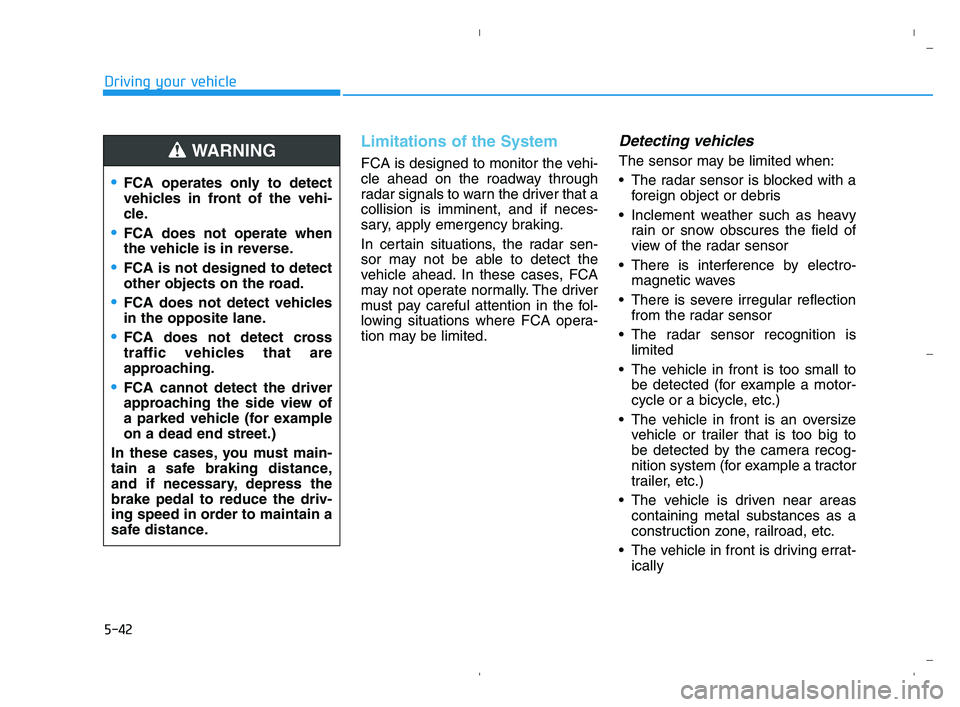
5-42
Driving your vehicle
Limitations of the System
FCA is designed to monitor the vehi-
cle ahead on the roadway through
radar signals to warn the driver that a
collision is imminent, and if neces-
sary, apply emergency braking.
In certain situations, the radar sen-
sor may not be able to detect the
vehicle ahead. In these cases, FCA
may not operate normally. The driver
must pay careful attention in the fol-
lowing situations where FCA opera-
tion may be limited.
Detecting vehicles
The sensor may be limited when:
The radar sensor is blocked with a
foreign object or debris
Inclement weather such as heavy
rain or snow obscures the field of
view of the radar sensor
There is interference by electro-
magnetic waves
There is severe irregular reflection
from the radar sensor
The radar sensor recognition is
limited
The vehicle in front is too small to
be detected (for example a motor-
cycle or a bicycle, etc.)
The vehicle in front is an oversize
vehicle or trailer that is too big to
be detected by the camera recog-
nition system (for example a tractor
trailer, etc.)
The vehicle is driven near areas
containing metal substances as a
construction zone, railroad, etc.
The vehicle in front is driving errat-
ically
FCA operates only to detect
vehicles in front of the vehi-
cle.
FCA does not operate when
the vehicle is in reverse.
FCA is not designed to detect
other objects on the road.
FCA does not detect vehicles
in the opposite lane.
FCA does not detect cross
traffic vehicles that are
approaching.
FCA cannot detect the driver
approaching the side view of
a parked vehicle (for example
on a dead end street.)
In these cases, you must main-
tain a safe braking distance,
and if necessary, depress the
brake pedal to reduce the driv-
ing speed in order to maintain a
safe distance.
WARNING
HCa HMA 5.QXP 5/25/2020 10:21 AM Page 42
Page 295 of 443
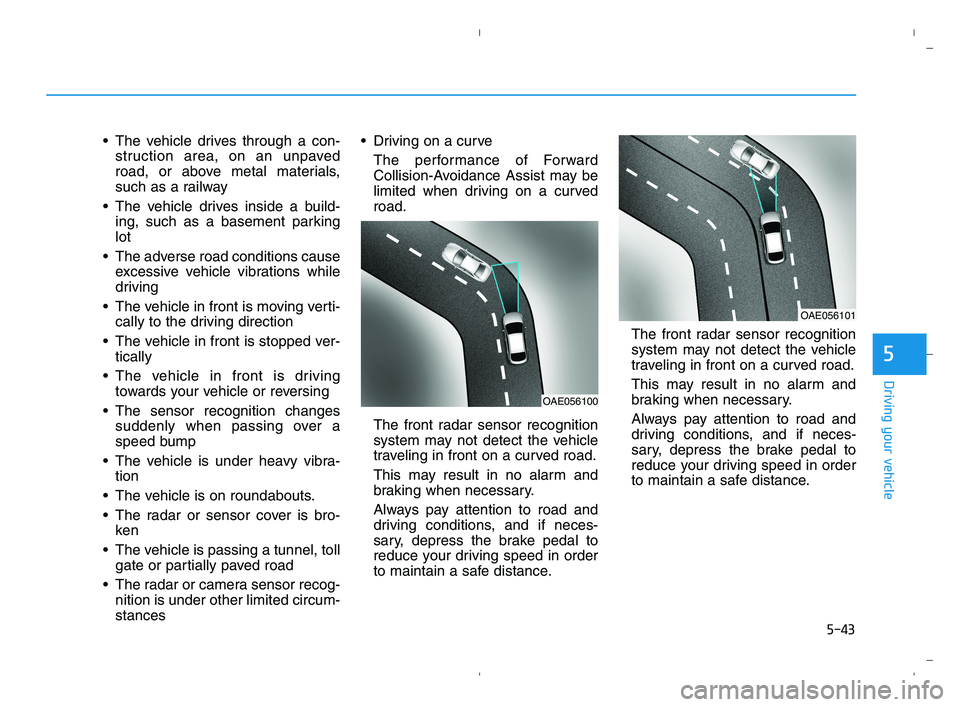
5-43
Driving your vehicle
5
The vehicle drives through a con-
struction area, on an unpaved
road, or above metal materials,
such as a railway
The vehicle drives inside a build-
ing, such as a basement parking
lot
The adverse road conditions cause
excessive vehicle vibrations while
driving
The vehicle in front is moving verti-
cally to the driving direction
The vehicle in front is stopped ver-
tically
The vehicle in front is driving
towards your vehicle or reversing
The sensor recognition changes
suddenly when passing over a
speed bump
The vehicle is under heavy vibra-
tion
The vehicle is on roundabouts.
The radar or sensor cover is bro-
ken
The vehicle is passing a tunnel, toll
gate or partially paved road
The radar or camera sensor recog-
nition is under other limited circum-
stances Driving on a curve
The performance of Forward
Collision-Avoidance Assist may be
limited when driving on a curved
road.
The front radar sensor recognition
system may not detect the vehicle
traveling in front on a curved road.
This may result in no alarm and
braking when necessary.
Always pay attention to road and
driving conditions, and if neces-
sary, depress the brake pedal to
reduce your driving speed in order
to maintain a safe distance.The front radar sensor recognition
system may not detect the vehicle
traveling in front on a curved road.
This may result in no alarm and
braking when necessary.
Always pay attention to road and
driving conditions, and if neces-
sary, depress the brake pedal to
reduce your driving speed in order
to maintain a safe distance.
OAE056100
OAE056101
HCa HMA 5.QXP 5/25/2020 10:21 AM Page 43
Page 296 of 443
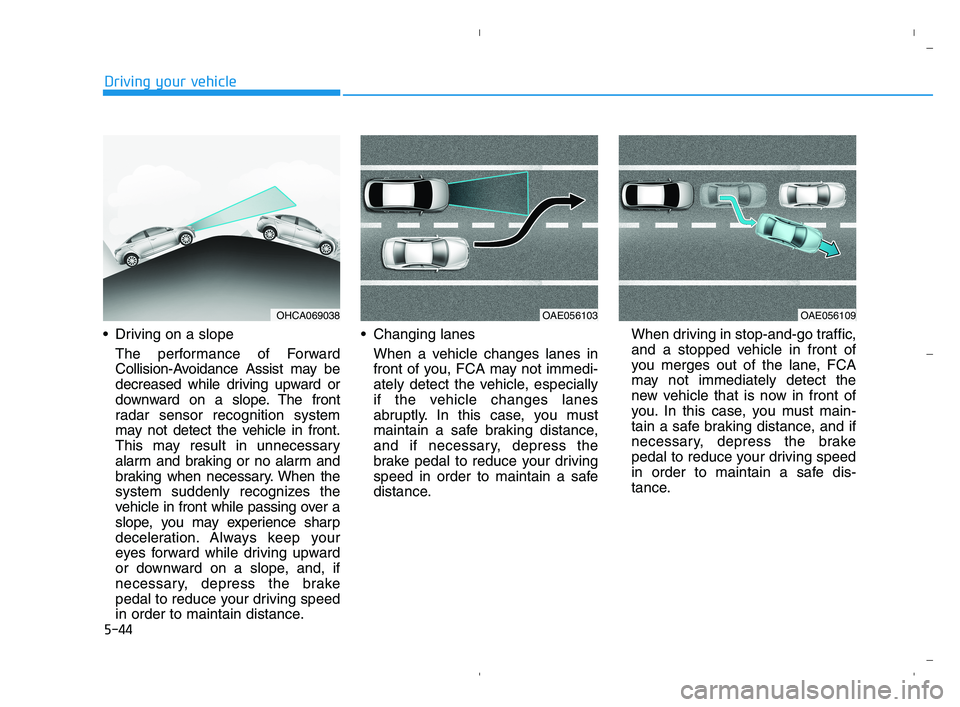
5-44
Driving your vehicle
Driving on a slope
The performance of Forward
Collision-Avoidance Assist may be
decreased while driving upward or
downward on a slope. The front
radar sensor recognition system
may not detect the vehicle in front.
This may result in unnecessary
alarm and braking or no alarm and
braking when necessary. When the
system suddenly recognizes the
vehicle in front while passing over a
slope, you may experience sharp
deceleration. Always keep your
eyes forward while driving upward
or downward on a slope, and, if
necessary, depress the brake
pedal to reduce your driving speed
in order to maintain distance. Changing lanes
When a vehicle changes lanes in
front of you, FCA may not immedi-
ately detect the vehicle, especially
if the vehicle changes lanes
abruptly. In this case, you must
maintain a safe braking distance,
and if necessary, depress the
brake pedal to reduce your driving
speed in order to maintain a safe
distance.When driving in stop-and-go traffic,
and a stopped vehicle in front of
you merges out of the lane, FCA
may not immediately detect the
new vehicle that is now in front of
you. In this case, you must main-
tain a safe braking distance, and if
necessary, depress the brake
pedal to reduce your driving speed
in order to maintain a safe dis-
tance.
OHCA069038OAE056103OAE056109
HCa HMA 5.QXP 5/25/2020 10:21 AM Page 44
Page 297 of 443
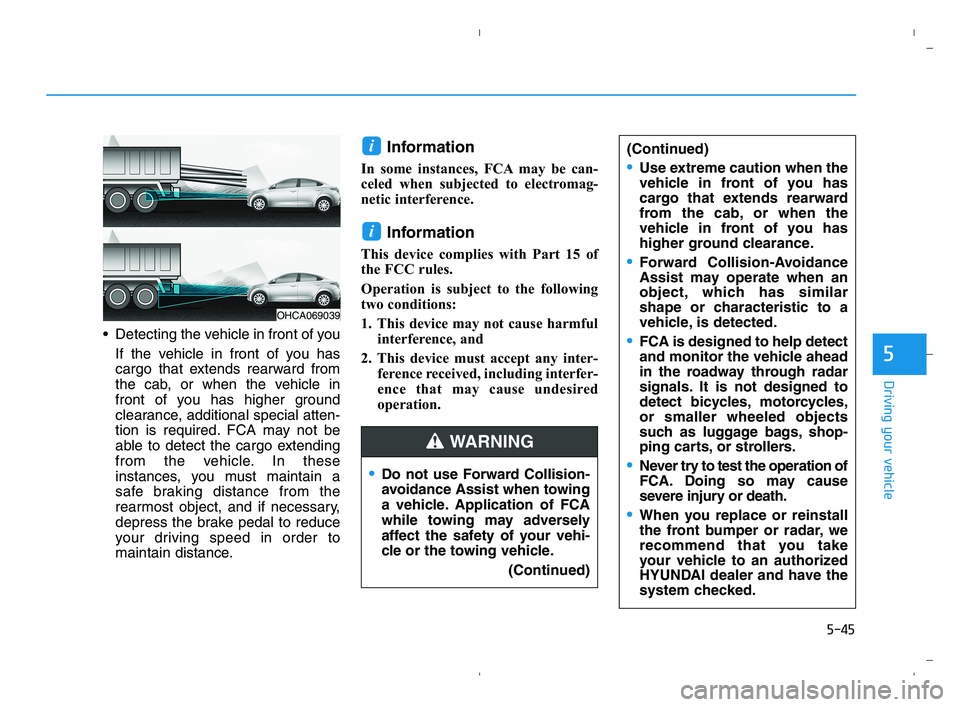
5-45
Driving your vehicle
5
Detecting the vehicle in front of you
If the vehicle in front of you has
cargo that extends rearward from
the cab, or when the vehicle in
front of you has higher ground
clearance, additional special atten-
tion is required. FCA may not be
able to detect the cargo extending
from the vehicle. In these
instances, you must maintain a
safe braking distance from the
rearmost object, and if necessary,
depress the brake pedal to reduce
your driving speed in order to
maintain distance.
Information
In some instances, FCA may be can-
celed when subjected to electromag-
netic interference.
Information
This device complies with Part 15 of
the FCC rules.
Operation is subject to the following
two conditions:
1. This device may not cause harmful
interference, and
2. This device must accept any inter-
ference received, including interfer-
ence that may cause undesired
operation.
i
i
OHCA069039
Do not use Forward Collision-
avoidance Assist when towing
a vehicle. Application of FCA
while towing may adversely
affect the safety of your vehi-
cle or the towing vehicle.
(Continued)
(Continued)
Use extreme caution when the
vehicle in front of you has
cargo that extends rearward
from the cab, or when the
vehicle in front of you has
higher ground clearance.
Forward Collision-Avoidance
Assist may operate when an
object, which has similar
shape or characteristic to a
vehicle, is detected.
FCA is designed to help detect
and monitor the vehicle ahead
in the roadway through radar
signals. It is not designed to
detect bicycles, motorcycles,
or smaller wheeled objects
such as luggage bags, shop-
ping carts, or strollers.
Never try to test the operation of
FCA. Doing so may cause
severe injury or death.
When you replace or reinstall
the front bumper or radar, we
recommend that you take
your vehicle to an authorized
HYUNDAI dealer and have the
system checked.
WARNING
HCa HMA 5.QXP 5/25/2020 10:21 AM Page 45
Page 298 of 443
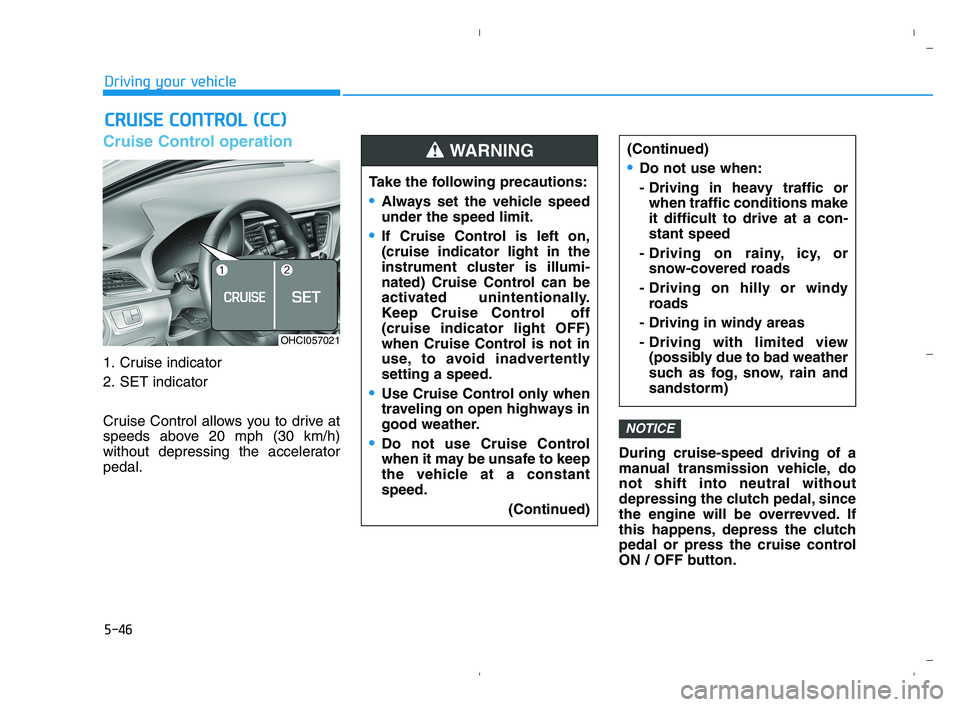
5-46
Driving your vehicle
Cruise Control operation
1. Cruise indicator
2. SET indicator
Cruise Control allows you to drive at
speeds above 20 mph (30 km/h)
without depressing the accelerator
pedal.During cruise-speed driving of a
manual transmission vehicle, do
not shift into neutral without
depressing the clutch pedal, since
the engine will be overrevved. If
this happens, depress the clutch
pedal or press the cruise control
ON / OFF button.
NOTICE
C CR
RU
UI
IS
SE
E
C
CO
ON
NT
TR
RO
OL
L
(
(C
CC
C)
)
(Continued)
Do not use when:
- Driving in heavy traffic or
when traffic conditions make
it difficult to drive at a con-
stant speed
- Driving on rainy, icy, or
snow-covered roads
- Driving on hilly or windy
roads
- Driving in windy areas
- Driving with limited view
(possibly due to bad weather
such as fog, snow, rain and
sandstorm)
OHCI057021
Take the following precautions:
Always set the vehicle speed
under the speed limit.
If Cruise Control is left on,
(cruise indicator light in the
instrument cluster is illumi-
nated) Cruise Control can be
activated unintentionally.
Keep Cruise Control off
(cruise indicator light OFF)
when Cruise Control is not in
use, to avoid inadvertently
setting a speed.
Use Cruise Control only when
traveling on open highways in
good weather.
Do not use Cruise Control
when it may be unsafe to keep
the vehicle at a constant
speed.
(Continued)
WARNING
HCa HMA 5.QXP 5/25/2020 10:21 AM Page 46
Page 299 of 443
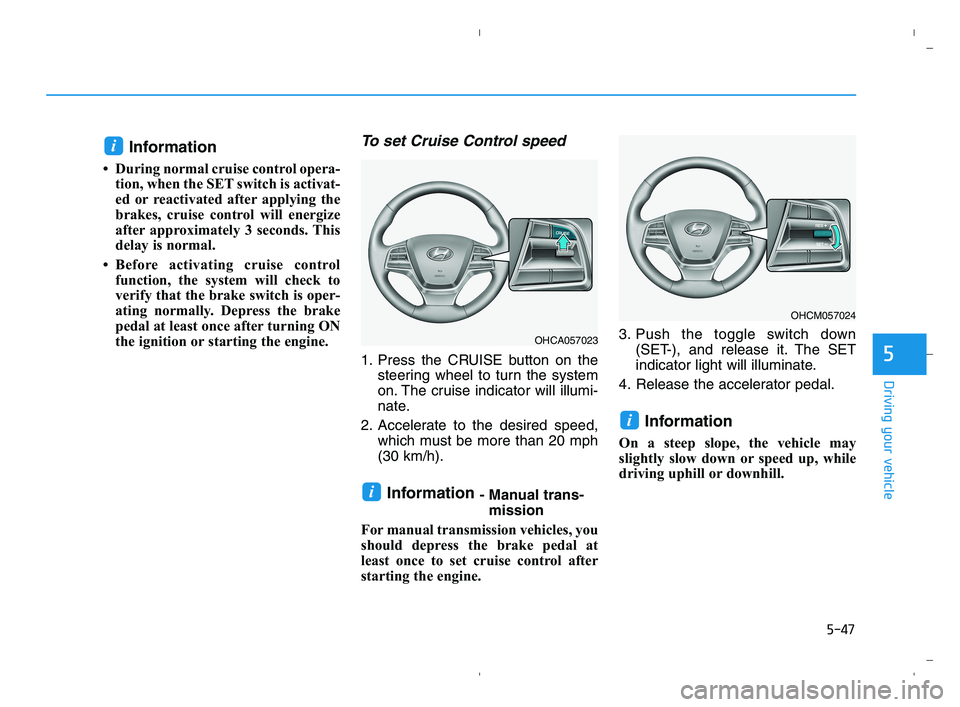
5-47
Driving your vehicle
5
Information
• During normal cruise control opera-
tion, when the SET switch is activat-
ed or reactivated after applying the
brakes, cruise control will energize
after approximately 3 seconds. This
delay is normal.
• Before activating cruise control
function, the system will check to
verify that the brake switch is oper-
ating normally. Depress the brake
pedal at least once after turning ON
the ignition or starting the engine.
To set Cruise Control speed
1. Press the CRUISE button on the
steering wheel to turn the system
on. The cruise indicator will illumi-
nate.
2. Accelerate to the desired speed,
which must be more than 20 mph
(30 km/h).
Information - Manual trans-
mission
For manual transmission vehicles, you
should depress the brake pedal at
least once to set cruise control after
starting the engine.3. Push the toggle switch down
(SET-), and release it. The SET
indicator light will illuminate.
4. Release the accelerator pedal.
Information
On a steep slope, the vehicle may
slightly slow down or speed up, while
driving uphill or downhill.
i
i
i
OHCA057023
OHCM057024
HCa HMA 5.QXP 5/25/2020 10:21 AM Page 47
Page 300 of 443
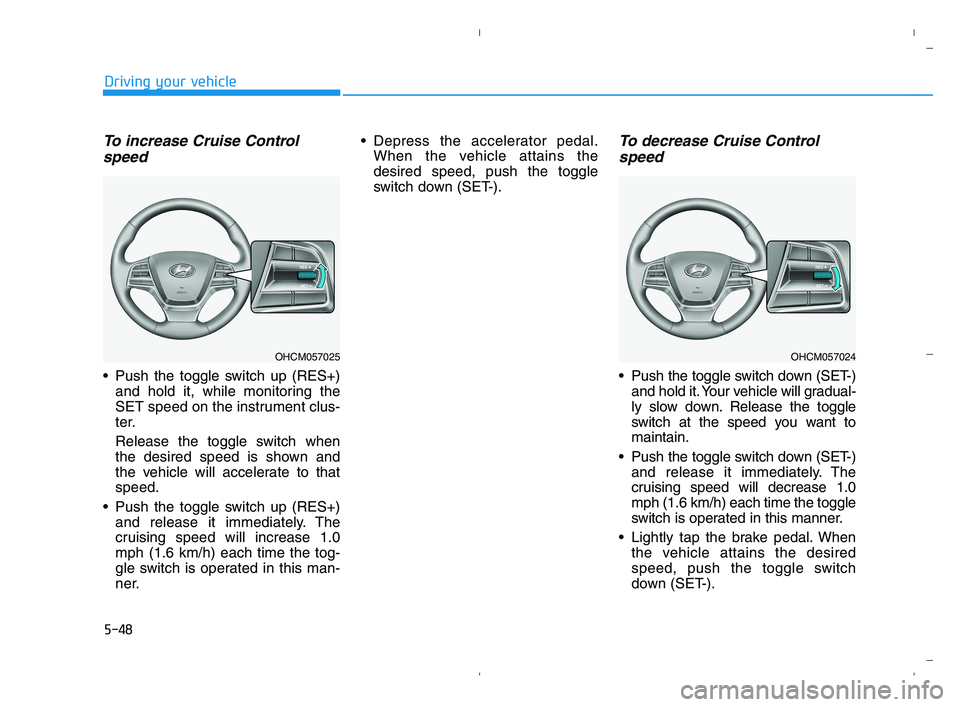
5-48
Driving your vehicle
To increase Cruise Control
speed
Push the toggle switch up (RES+)
and hold it, while monitoring the
SET speed on the instrument clus-
ter.
Release the toggle switch when
the desired speed is shown and
the vehicle will accelerate to that
speed.
Push the toggle switch up (RES+)
and release it immediately. The
cruising speed will increase 1.0
mph (1.6 km/h) each time the tog-
gle switch is operated in this man-
ner. Depress the accelerator pedal.
When the vehicle attains the
desired speed, push the toggle
switch down (SET-).
To decrease Cruise Control
speed
Push the toggle switch down (SET-)
and hold it. Your vehicle will gradual-
ly slow down. Release the toggle
switch at the speed you want to
maintain.
Push the toggle switch down (SET-)
and release it immediately. The
cruising speed will decrease 1.0
mph (1.6 km/h) each time the toggle
switch is operated in this manner.
Lightly tap the brake pedal. When
the vehicle attains the desired
speed, push the toggle switch
down (SET-).
OHCM057025OHCM057024
HCa HMA 5.QXP 5/25/2020 10:22 AM Page 48